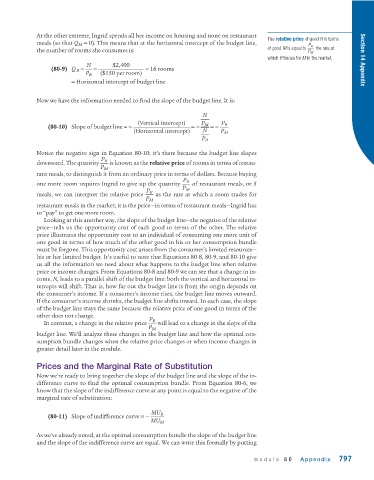Page 839 - Krugmans Economics for AP Text Book_Neat
P. 839
At the other extreme, Ingrid spends all her income on housing and none on restaurant
The relative price of good R in terms
meals (so that Q M = 0). This means that at the horizontal intercept of the budget line, P R
the number of rooms she consumes is: of good M is equal to P M , the rate at
which R trades for M in the market. Section 14 Appendix
(80-9) Q R = N = $2,400 = 16 rooms
P R ($150 per room)
= Horizontal intercept of budget line
Now we have the information needed to find the slope of the budget line. It is:
N
(80-10) Slope of budget line = − (Vertical intercept) = − P M = − P R
(Horizontal intercept) N P M
P R
Notice the negative sign in Equation 80-10; it’s there because the budget line slopes
P R
downward. The quantity is known as the relative price of rooms in terms of restau-
P M
rant meals, to distinguish it from an ordinary price in terms of dollars. Because buying
P R
one more room requires Ingrid to give up the quantity of restaurant meals, or 5
P M
P R
meals, we can interpret the relative price as the rate at which a room trades for
P M
restaurant meals in the market; it is the price—in terms of restaurant meals—Ingrid has
to “pay” to get one more room.
Looking at this another way, the slope of the budget line—the negative of the relative
price—tells us the opportunity cost of each good in terms of the other. The relative
price illustrates the opportunity cost to an individual of consuming one more unit of
one good in terms of how much of the other good in his or her consumption bundle
must be forgone. This opportunity cost arises from the consumer’s limited resources—
his or her limited budget. It’s useful to note that Equations 80-8, 80-9, and 80-10 give
us all the information we need about what happens to the budget line when relative
price or income changes. From Equations 80-8 and 80-9 we can see that a change in in-
come, N, leads to a parallel shift of the budget line: both the vertical and horizontal in-
tercepts will shift. That is, how far out the budget line is from the origin depends on
the consumer’s income. If a consumer’s income rises, the budget line moves outward.
If the consumer’s income shrinks, the budget line shifts inward. In each case, the slope
of the budget line stays the same because the relative price of one good in terms of the
other does not change.
P R
In contrast, a change in the relative price will lead to a change in the slope of the
P M
budget line. We’ll analyze these changes in the budget line and how the optimal con-
sumption bundle changes when the relative price changes or when income changes in
greater detail later in the module.
Prices and the Marginal Rate of Substitution
Now we’re ready to bring together the slope of the budget line and the slope of the in-
difference curve to find the optimal consumption bundle. From Equation 80-6, we
know that the slope of the indifference curve at any point is equal to the negative of the
marginal rate of substitution:
(80-11) Slope of indifference curve = − MU R
MU M
As we’ve already noted, at the optimal consumption bundle the slope of the budget line
and the slope of the indifference curve are equal. We can write this formally by putting
module 80 Appendix 797

